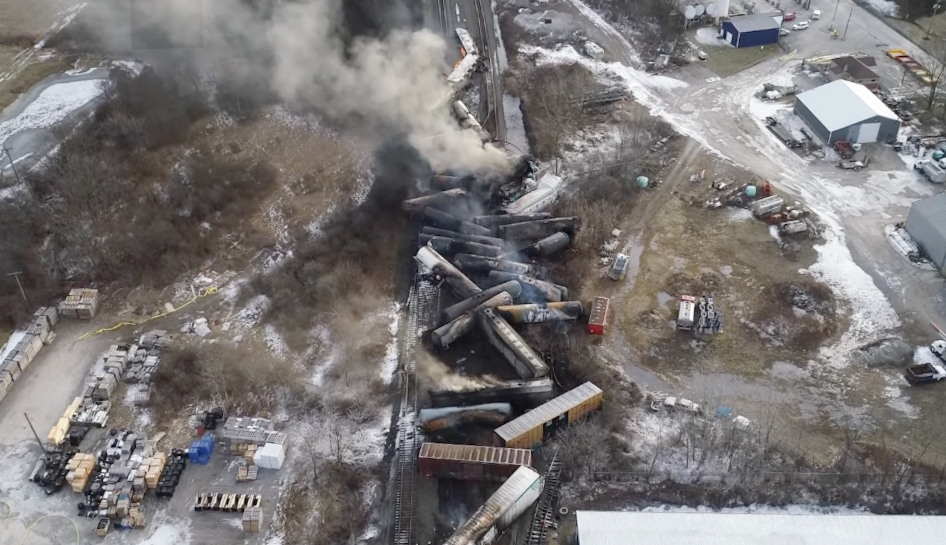Ohio Train Derailment: The Lingering Threat Of Toxic Chemicals In Buildings

Table of Contents
Pathways of Chemical Contamination in Buildings Following the Derailment
The derailment released a plume of toxic chemicals into the environment, creating multiple pathways for contamination to reach buildings. Understanding how these chemicals spread is vital for assessing risk and implementing effective remediation strategies. The spread wasn't limited to the immediate vicinity; airborne particles, water runoff, and soil contamination extended the reach of the hazard.
- Airborne Particulate Matter: The initial explosion and subsequent burning of the chemicals created a cloud of airborne particulate matter containing toxic substances. This settled on surfaces both inside and outside of buildings, potentially leading to long-term exposure. Cleaning alone may not be sufficient to eliminate the risk; thorough testing is crucial.
- Contaminated Water Runoff: Rainfall and snowmelt washed chemicals from the derailment site into the surrounding water systems. This contaminated water could have infiltrated basements, seeped into plumbing systems, and even contaminated private wells, introducing toxic chemicals directly into buildings. Water testing is essential to detect this form of contamination.
- Chemical Absorption into Building Materials: Porous building materials such as drywall, insulation, and even wood can absorb toxic chemicals from the air or contaminated water. This means the chemicals can persist within the building structure, leading to prolonged exposure long after the initial event.
- Long-Term Leaching from Contaminated Soil: The soil surrounding the derailment site is likely contaminated with toxic chemicals. These chemicals can leach into building foundations over time, gradually contaminating the building's interior. This is a particularly insidious form of contamination, as it may not be immediately apparent.
Health Risks Associated with Toxic Chemical Exposure in Buildings
Exposure to the toxic chemicals released during the derailment poses significant health risks, both short-term and long-term. The severity of these risks depends on factors such as the concentration of the chemicals, the duration of exposure, and individual sensitivities. Vinyl Chloride, for example, is a known carcinogen, increasing the risk of various cancers with prolonged exposure.
- Short-Term Effects: Symptoms of exposure can include respiratory problems like coughing and shortness of breath, skin irritation and rashes, headaches, dizziness, and nausea.
- Long-Term Effects: Long-term exposure to these chemicals may lead to serious health problems, including various types of cancer, neurological disorders, and other chronic illnesses. Children and individuals with pre-existing health conditions are particularly vulnerable.
- Vulnerable Populations: The impact on pregnant women, infants, young children, and the elderly warrants special attention due to their increased susceptibility to the toxic effects of these chemicals. Protecting these populations should be a top priority.
Testing and Remediation Strategies for Toxic Chemicals in Buildings
If you live or work in an area affected by the Ohio train derailment, it's crucial to have your building professionally tested for chemical contamination. This involves various types of testing to identify the presence and concentration of specific toxic chemicals.
- Air Quality Testing: This assesses the levels of airborne contaminants within the building.
- Water Testing: Testing the water supply, both municipal and private wells, is vital to rule out contamination.
- Surface Testing: This involves testing surfaces within the building for the presence of chemical residue.
- Remediation Methods: Depending on the results of the testing, various remediation methods may be necessary. These can range from air purification systems to complete decontamination of surfaces and, in severe cases, the removal and replacement of contaminated building materials. Proper disposal of contaminated materials is critical to prevent further environmental damage. The effectiveness of each method depends on the extent and type of contamination.
The Environmental Protection Agency (EPA) and Ohio's Environmental Protection Agency (Ohio EPA) play a crucial role in overseeing testing and remediation efforts, providing guidance and enforcing regulations.
Legal and Financial Implications of Toxic Chemical Contamination
Homeowners and businesses affected by the Ohio train derailment may have legal recourse to recover damages resulting from the contamination. Navigating the legal and financial aspects can be complex.
- Insurance Claims: Filing insurance claims for environmental contamination can be challenging, as many standard homeowner's and business insurance policies may have exclusions for this type of damage.
- Lawsuits: Legal action against the responsible parties may be necessary to secure compensation for damages. Seeking advice from an experienced environmental law attorney is highly recommended.
- Government Assistance: Depending on the extent of the damage and the specific circumstances, government assistance programs may be available to help cover the costs of testing and remediation.
Conclusion: Protecting Your Home and Community from the Lingering Threat of Toxic Chemicals in Buildings
The Ohio train derailment serves as a stark reminder of the long-term consequences of environmental disasters. The lingering threat of toxic chemicals in buildings demands immediate attention and proactive steps. Testing for contamination is crucial, and appropriate remediation strategies must be implemented to protect the health and well-being of residents and communities. Do not hesitate to contact your local health department, the EPA, or the Ohio EPA for guidance and assistance. If you suspect contamination in your building, seek professional testing and remediation services immediately. Protecting yourself and your family from the dangers of toxic chemicals in buildings is paramount. Learn more and find resources at [link to EPA website] and [link to Ohio EPA website].

Featured Posts
-
 Trump Affirms No Plans To Fire Jerome Powell As Federal Reserve Chair
Apr 24, 2025
Trump Affirms No Plans To Fire Jerome Powell As Federal Reserve Chair
Apr 24, 2025 -
 Understanding High Stock Market Valuations Bof As Perspective For Investors
Apr 24, 2025
Understanding High Stock Market Valuations Bof As Perspective For Investors
Apr 24, 2025 -
 John Travoltas Lowest Rated Movies A Rotten Tomatoes Analysis
Apr 24, 2025
John Travoltas Lowest Rated Movies A Rotten Tomatoes Analysis
Apr 24, 2025 -
 Nancy Mace Faces Angry Voter In South Carolina Details Of The Confrontation
Apr 24, 2025
Nancy Mace Faces Angry Voter In South Carolina Details Of The Confrontation
Apr 24, 2025 -
 How Middle Management Drives Company Performance And Employee Satisfaction
Apr 24, 2025
How Middle Management Drives Company Performance And Employee Satisfaction
Apr 24, 2025
